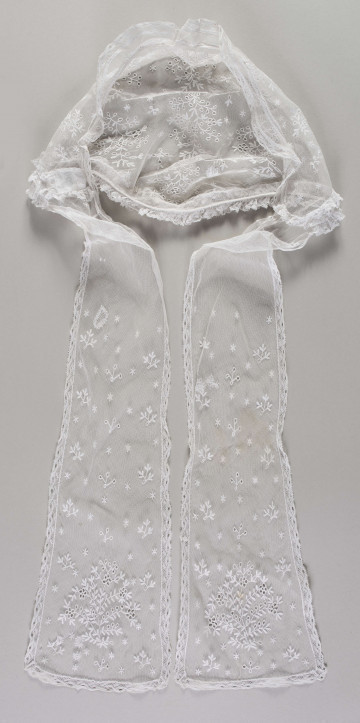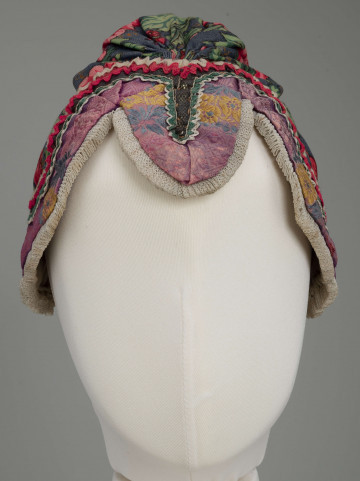
Mesh cap `chamełka`
1895 — 1914
National Museum in Lublin
Part of the collection: Folk craft of the Lublin Region (19th/20th c.)
The haunch, i.e., ‘skośniak’, (also called ‘dupka’) is a headdress worn by married women to the Zamość festive costume. It comes from the village of Zabuże, but its maker and year of origin are unknown. It was worn from the end of the 19th century until the 1920s, replacing the bonnet type called the net bonnet. Like the previous one, it consisted of two oval rings made of hazel, called obiecaina (10 cm long and 7.5 cm wide). The larger one was covered with a piece of woollen Tibetan shawl, with or without a fringe, of factory production, commonly called shawl. This fabric was specially fixed so that there was a decorative motif in the middle of the bottom, in this case a large pink flower. The edge of the rim was hemmed with a strip of the same fabric, leaving two loose ends at about 8-10 cm at the bottom, where a corner of the shawl was sewn underneath. This created a semi-circular corner 18-20 cm long. Usually ¼ of a woollen shawl was used for one corner. It was a small ornament, which had to be fixed correctly at the back of the head on shoulder-length loose hair. To this end, first a bundle of hair was threaded through a smaller promise and then a larger hoop covered with Tibetan fabric was placed over it. The headdress was worn mainly by young married women, who could not leave the house with a bare head because of their marital status.
Author / creator
Dimensions
cały obiekt: height: 7,5 cm, width: 10 cm
Object type
headgear
Technique
sewing
Material
wood, fabric
Creation time / dating
Creation / finding place
Owner
The National Museum in Lublin
Identification number
Location / status

1895 — 1914
National Museum in Lublin

1901 — 1950
National Museum in Lublin

1914
National Museum in Lublin
DISCOVER this TOPIC
Castle Museum in Łańcut
DISCOVER this PATH
Educational path